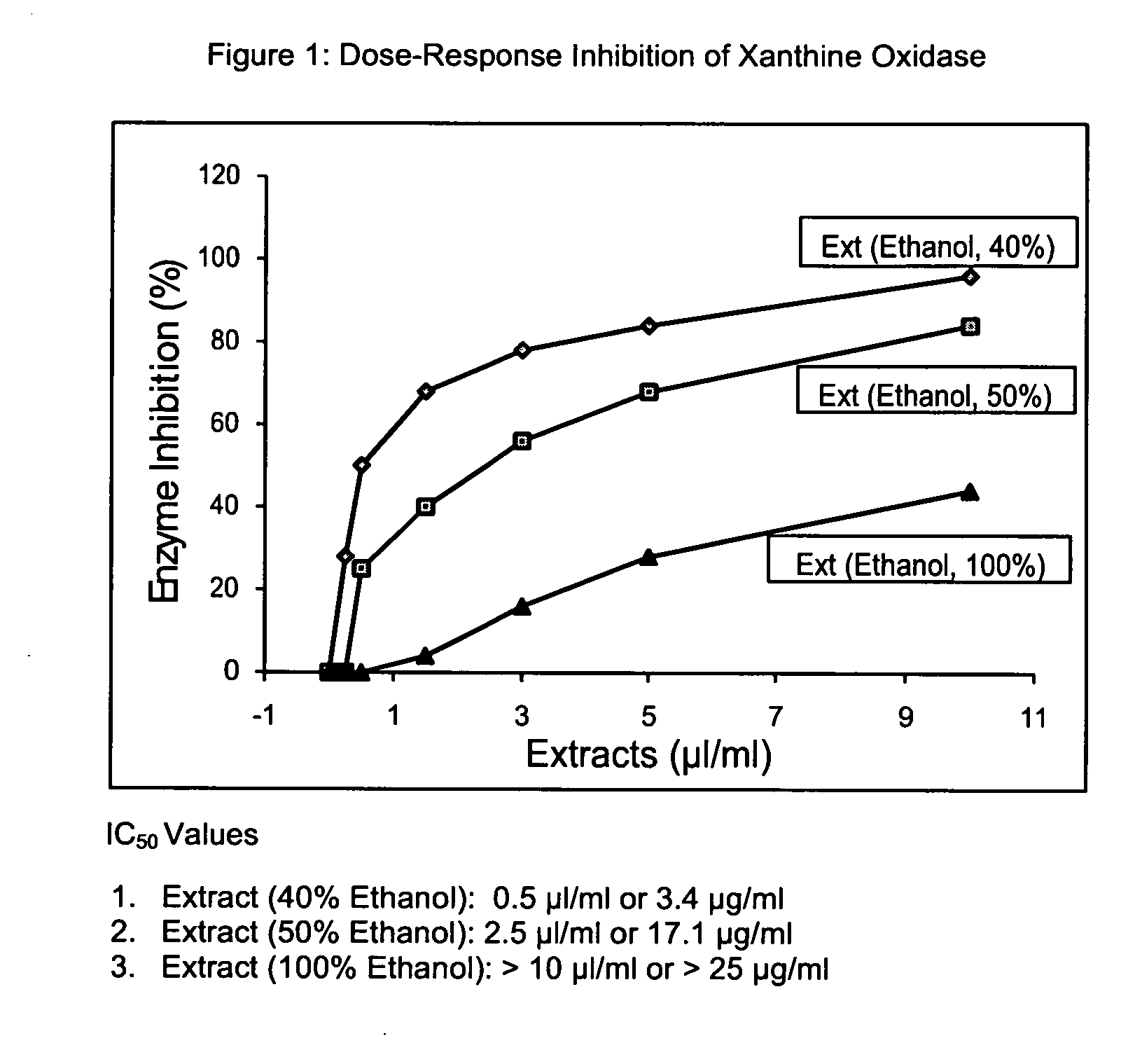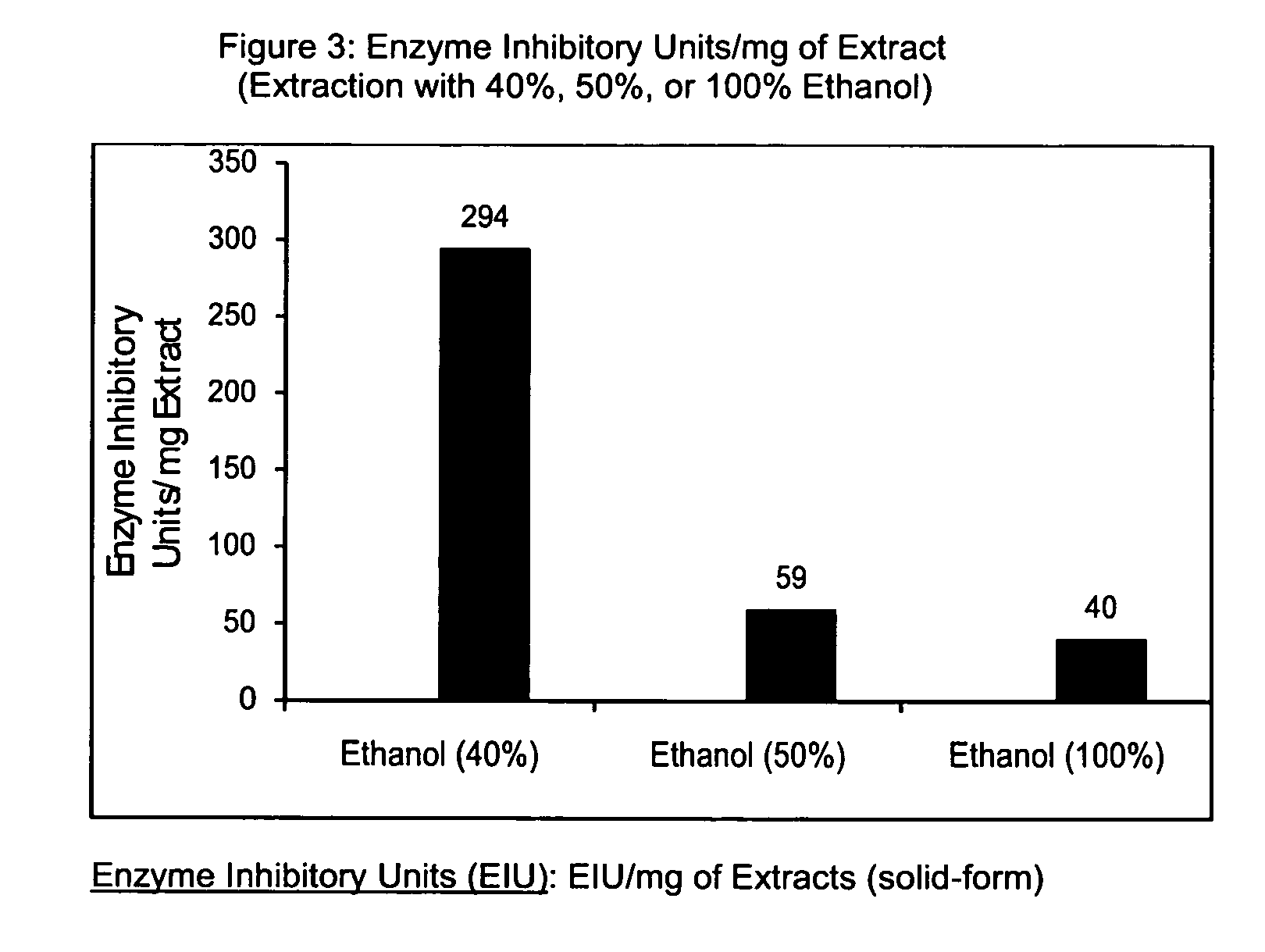Development of biochemically standardized extracts from fresh rhizomes of turmeric (curcuma longa) for treatment of diseases caused by hyperuricemia
a technology of curcuma longa and extracts, which is applied in the field the extraction of curcuma longa rhizomes, can solve the problems of not understanding the mechanism of action that can explain the therapeutic effect of curcuma, and no available method of biochemical standardization of turmeric powder or extracts, so as to prevent the degradation of hypoxanthine and prevent tissue damage to the heart or brain
- Summary
- Abstract
- Description
- Claims
- Application Information
AI Technical Summary
Benefits of technology
Problems solved by technology
Method used
Image
Examples
example 1
Extraction of Turmeric Powder
[0038]Preparation of extracts from fresh turmeric rhizome powder: Extracts are prepared using ethanol (40%), ethanol (50%), or ethanol (100%) in a ratio 1:40 (powder:solvent) by constant gentle stirring at room temperature. Experiments outlined here have used 0.25 gm turmeric powder and 10 ml of the solvent for each extraction. After 20 hours of gentle stirring, each extract is centrifuged for 30 min at 12,000 rpm to remove insoluble turmeric residue. Clear extracts are collected and used in studies described below. The amount of the dissolved herb per ml of each extract is determined by drying an aliquot (4 ml) of the extract at 40-42° C. overnight in a temperature-controlled oven. The dried contents are 5.85, 6.64, and 2.60 mg / ml of 40% ethanol, 50% ethanol, and 100% ethanol extracts respectively.
example 2
Hypoxanthine Production and Xanthine Oxidase Enzyme Assay
[0039]The cellular adenosine 5′-triphosphate (ATP) is enzymatically converted into hypoxanthine. The common pathway for production of hypoxanthine involves: ATP>>ADP>>AMP>>Adenosine>>Inosine>>Hypoxanthine.
[0040]Xanthine oxidase is the key enzyme that catalyzes the following reactions with the formation of uric acid, hydrogen peroxide, and oxygen free radicals.
Hypoxanthine+O2+H2O→Xanthine+H2O2+O2−.
Xanthine+O2+H2O→UricAcid+H2O2+O2−.
[0041]The turmeric extracts as obtained above are used to examine the effects on xanthine oxidase activity. Xanthine oxidase assay involves measurement of enzymatic conversion of hypoxanthine into uric acid, which is measured spectrophotometerically. The assay is performed in 50 mM Tris-HCl buffer (pH 8.0) containing 50 μM hypoxanthine. After incubation at 25° C. for 2-3 min, the enzymatic reaction is initiated by addition of an appropriate amount of xanthine oxidase purchased from Sigma Chemical Co...
example 3
Inhibition of Xanthine Oxidase
[0042]The IC50 values have been determined by examining the dose-response effects of the extracts. The IC50 values represent the amount of the extract, μl (extract) or μg (dried-form of extract) per ml of the reaction mixture, producing the enzyme inhibition by 50%. In the enzyme assay, first a background reading is recorded on the chart for 1-2 min, followed by the addition of an appropriate amount of the enzyme to start the reaction, and the production of uric acid is monitored at 293 nm as above. The amount of the extract added to the reaction mixture depends on the enzyme inhibition. Normally, various amounts of the enzyme are selected, which give the enzyme inhibition from 10% to about 100%. FIG. 1 shows the IC50 values, which are determined from the dose-response effects of the turmeric extracts on xanthine oxidase. The extract prepared with 40% ethanol shows a much stronger inhibition of xanthine oxidase (IC50, 3.4 μg / ml) as compared to 50% ethan...
PUM
 Login to View More
Login to View More Abstract
Description
Claims
Application Information
 Login to View More
Login to View More - R&D
- Intellectual Property
- Life Sciences
- Materials
- Tech Scout
- Unparalleled Data Quality
- Higher Quality Content
- 60% Fewer Hallucinations
Browse by: Latest US Patents, China's latest patents, Technical Efficacy Thesaurus, Application Domain, Technology Topic, Popular Technical Reports.
© 2025 PatSnap. All rights reserved.Legal|Privacy policy|Modern Slavery Act Transparency Statement|Sitemap|About US| Contact US: help@patsnap.com



